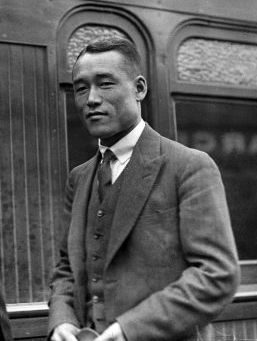Jiro Sato facts for kids

Jiro Sato in 1932 at Central Station, Sydney
|
|
| Country (sports) | |
|---|---|
| Born | January 5, 1908 Gunma Prefecture, Empire of Japan |
| Died | April 5, 1934 (aged 26) Strait of Malacca |
| Turned pro | 1929 (amateur tour) |
| Retired | 1934 (death) |
| Plays | Right-handed |
| Singles | |
| Career record | 128-26 (83.1%) |
| Career titles | 18 |
| Highest ranking | No. 3 (1933, A. Wallis Myers) |
| Grand Slam singles results | |
| Australian Open | SF (1932) |
| French Open | SF (1931, 1933) |
| Wimbledon | SF (1932, 1933) |
| US Open | 4R (1933) |
| Doubles | |
| Grand Slam doubles results | |
| Wimbledon | F (1933) |
| Mixed doubles | |
| Grand Slam mixed doubles results | |
| Australian Open | F (1932) |
Jiro Sato (佐藤 次郎, Satō Jirō, Japanese pronunciation: [sa.toː dʑi.ɾoː]; January 5, 1908 – April 5, 1934) was a super talented Japanese tennis player. He became one of the best in the world, reaching No. 3 in 1933! Sadly, his life ended too soon during a trip for a big tennis tournament in 1934.
Jiro Sato became famous around the world, especially at Wimbledon in 1932. He beat the champion, Sidney Wood, in a thrilling match. In 1933, he was at his best, even beating tennis legend Fred Perry at the French Open. He was ranked third in the world by a famous tennis writer, A. Wallis Myers. But Jiro felt a lot of pressure from his home country, Japan. This pressure might have been too much for him. He disappeared from a ship on April 5, 1934, when he was just 26 years old.
Contents
Jiro Sato's Tennis Journey
Jiro Sato started his international tennis career in 1929. He played against famous tennis players from the Racing Club de Paris when they visited Japan. He even beat some big names like Jacques Brugnon! His only loss was to the great Henri Cochet.
In 1930, Jiro was the runner-up at the All Japan Championships, but he came back and won it the very next year. He also played in other tournaments, showing off his skills.
During 1931, Jiro won many titles. He won the singles and doubles at the West of England Championships. He also won 13 singles titles in Great Britain between July and November 1931! He teamed up with other players to win doubles titles too, like at the German Championships in 1933 with his friend Ryosuke Nunoi.
Jiro was a key player for the Japanese Davis Cup team. From 1931 to 1933, he played in ten team matches, winning 22 games and only losing six. That's a fantastic winning record of 79%!
How Jiro Played Tennis
Jiro Sato had a special way of playing. He hit the ball with a very flat forehand shot. He learned this style from Henri Cochet, who visited Japan in 1929. Jiro would hit the ball very early after it bounced, which made it hard for his opponents. He was also excellent at hitting the ball close to the net, which is called volleying.
Jiro's Life Outside Tennis
Jiro Sato went to Waseda University where he studied economics. However, he decided to stop his studies in 1933 to focus completely on his tennis career. He had an older brother, Hyotaro Sato, who was also a tennis player. In 1934, Jiro was engaged to Sanae Okada, who was one of Japan's best female tennis players.
A Sad Disappearance
On April 4, 1934, Jiro Sato was on a ship called the N.Y.K. Hakone Maru. He was traveling to Europe for the 1934 International Lawn Tennis Challenge, also known as the Davis Cup. He was supposed to play against the Australia Davis Cup team.
During the trip, Jiro felt unwell and was very nervous. He was under a lot of pressure to do well for his country. He even thought about leaving the ship in Singapore to see a doctor, but the examination didn't find any physical problems. It seemed his worries were mostly in his mind. The Japanese consul and his teammates encouraged him to continue the journey. The Japanese Lawn Tennis Association also sent a message, insisting that Jiro must play in the Davis Cup.
Late on April 5, 1934, Jiro Sato was found to be missing from the ship. He was last seen having dinner in his cabin. A search was carried out for many hours, and other ships were contacted. It was believed that he had gone into the Strait of Malacca and drowned.
The next day, his friends on the ship held a special prayer for him. They made a small memorial with his photos and tennis racquets. It was thought that the huge pressure from the Japanese Empire and the tennis association, who didn't want him to take a break, made him feel very sad and worried about his tennis skills.
Jiro's brother, Hyotaro Sato, later asked the Japanese tennis team not to give up and to play their very best in the Davis Cup, honoring Jiro's memory.
Images for kids


